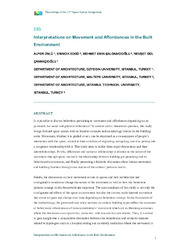Interpretations on movement and affordances in the built environment
| dc.contributor.author | Ünlü, Alper | |
| dc.contributor.author | Edgü, E. | |
| dc.contributor.author | Şalgamcioğlu, M. E. | |
| dc.contributor.author | Çanakçıoğlu, Nevşet Gül | |
| dc.date.accessioned | 2023-08-07T08:37:00Z | |
| dc.date.available | 2023-08-07T08:37:00Z | |
| dc.date.issued | 2022 | |
| dc.identifier.isbn | 978-829367767-3 | |
| dc.identifier.uri | http://hdl.handle.net/10679/8576 | |
| dc.identifier.uri | https://www.hvl.no/globalassets/hvl-internett/arrangement/2022/13sss/395unlu.pdf | |
| dc.description.abstract | Is it possible to discuss behaviour pertaining to movement and affordances depending on its potentials for social and physical reflections? To answer such a theoretical question, this study brings forward space syntax with its broader concepts and morphology studies in the building scale. Movement, whether it is guided or not, can be examined as a consequence of people’s interaction with the space, related to their activities of exploring, navigating, and also getting into a congruent relationship with it. This study aims to tackle three major discussions and their interrelationships. Firstly, affordance and syntactic relationship in relation to the nature of the movement through space; secondly the relationship between building programming and its behavioural occurrences, and finally presenting a dialectic discussion about human movement and building function through case studies of the authors’ previous works. Herein, the discussions on how movement occurs in spaces and how architecture and configurative conditions change the nature of the movement as well as how the behaviour patterns emerge in this framework are important. The main emphasis of this study is not only the configurational effects of the space on movement but also the various multi-layered movement that occur in space and change over time depending on behaviour settings. In the framework of the methodology, the presented case study sections on various building types reflect the outcomes of behavioural observations of various individuals’ movement which act as liberating outcomes where the discussions on copresence, encounter, and coawareness are crucial. Thus, it is aimed to gain insight into a comparative discussion between the behavioural and syntactic datasets related to typologies such as a hospital setting and an elderly institution where the movement is assumed to be more dictating as well as other typologies such as university buildings and exhibition halls where the movement is assumed to be more spontaneous. With this in-depth synthesis and discussion based on the previous case study findings of the researchers, it has been noticed that many variable situations can be observed in which behaviour settings are highly influential on movement regardless of the building program depending on people's age, professional roles, gender, and life cycles. | en_US |
| dc.language.iso | eng | en_US |
| dc.publisher | Western Norway University of Applied Sciences (HVL) | en_US |
| dc.relation.ispartof | Proceedings 13th International Space Syntax Symposium, SSS 2022 | |
| dc.rights | openAccess | |
| dc.title | Interpretations on movement and affordances in the built environment | en_US |
| dc.type | Conference paper | en_US |
| dc.publicationstatus | Published | en_US |
| dc.contributor.department | Özyeğin University | |
| dc.contributor.authorID | (ORCID 0000-0002-8289-3601 & YÖK ID 159795) Çanakçıoğlu, Gül | |
| dc.contributor.authorID | (ORCID 0000-0002-6134-4726 & YÖK ID 13117) Ünlü, Alper | |
| dc.contributor.ozuauthor | Ünlü, Alper | |
| dc.contributor.ozuauthor | Çanakçıoğlu, Nevşet Gül | |
| dc.subject.keywords | Affordance | en_US |
| dc.subject.keywords | Behaviour setting | en_US |
| dc.subject.keywords | Coawareness | en_US |
| dc.subject.keywords | Copresence | en_US |
| dc.subject.keywords | Encounter | en_US |
| dc.subject.keywords | Isovist | en_US |
| dc.subject.keywords | Movement | en_US |
| dc.identifier.scopus | SCOPUS:2-s2.0-85145578724 | |
| dc.relation.publicationcategory | Conference Paper - International - Institutional Academic Staff |
Files in this item
This item appears in the following Collection(s)
Share this page



